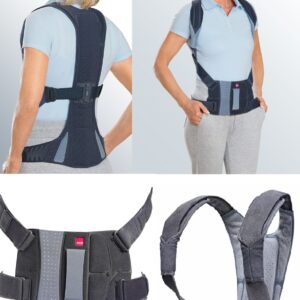Understanding Osteoporosis: A Path to Wellness
Osteoporosis is one of those conditions that often creeps up on us quietly. I remember when I first learned about it—how easy it seemed for someone like me to dismiss it as something that wouldn’t affect my life. I’d heard the term before, but it always seemed like something distant, something that happened to other people. But over time, I began noticing friends, family members, and even acquaintances who had struggled with their bones breaking, losing strength, and experiencing limitations they hadn’t anticipated.
It wasn’t until one of my loved ones was diagnosed with osteoporosis that I began to truly understand how much this condition could affect daily life. Osteoporosis can alter everything—how we move, how we think about our health, and how we care for our bodies. It’s easy to feel overwhelmed, but what I’ve learned along the way is that there’s so much we can do to manage osteoporosis and live our lives fully, with strength and vitality.
If you’re reading this, maybe you’ve just been diagnosed, or maybe you’re simply trying to understand this condition better to protect your own health. Either way, you’re not alone. Osteoporosis doesn’t define you, but it’s important to understand it and learn how to live well with it. In this post, we’re going to explore everything you need to know about osteoporosis, from its causes and symptoms to practical steps you can take to strengthen your bones and mind.
What is Osteoporosis?
Osteoporosis, often referred to as “the silent disease,” is a condition in which the bones become weak and brittle. This occurs because the body loses too much bone mass or doesn’t produce enough new bone to keep up with the natural process of bone turnover. As a result, bones can become fragile, and even minor falls or injuries can lead to fractures, often in places like the hips, wrists, and spine.
At a deeper level, the body is constantly remodeling its bones. Bone tissue is broken down and rebuilt at all stages of life, but when you have osteoporosis, this process becomes imbalanced. More bone is broken down than is replaced, which causes a reduction in bone density. This makes the bones weaker, leading to a higher likelihood of fractures.
But let’s back up for a moment and talk about bone health in general. Our bones are living tissues that are constantly being remodeled. Every day, old bone is broken down and replaced by new bone tissue. When we’re younger, this process happens at a fast pace, and our bones stay strong. But as we age, the rate at which we build new bone slows down, while the rate of bone loss continues. This imbalance between bone loss and bone formation is what leads to osteoporosis.
Osteoporosis doesn’t just affect older adults, but the condition is most common in those over the age of 50. In fact, women are at a higher risk, particularly after menopause when the drop in estrogen can accelerate bone loss. However, osteoporosis can affect anyone, including men, especially as they get older or if they have certain risk factors like low testosterone levels.
Causes of Osteoporosis
While there’s no single cause of osteoporosis, there are a variety of factors that contribute to the condition. These include genetic factors, lifestyle choices, medications, and even medical conditions that impact bone health.
- Genetic Factors: Family history plays a big role. If someone in your family has had osteoporosis, you may be more likely to develop it yourself. This is especially true if your parents or siblings had fractures related to bone weakness.
- Hormonal Imbalances: Estrogen plays a major role in bone health, and a decrease in estrogen levels after menopause significantly increases the risk of developing osteoporosis in women. Similarly, men who have low testosterone levels also face a higher risk.
- Nutritional Deficiencies: Insufficient calcium and vitamin D intake can lead to weakened bones. Calcium helps build bone strength, while vitamin D is essential for calcium absorption in the body.
- Physical Inactivity: A lack of exercise, particularly weight-bearing activities such as walking, jogging, or strength training, can cause bone loss. Bones, like muscles, need stimulation to stay strong, and physical activity provides that stimulation.
- Medications: Certain medications, especially steroids and some anticonvulsants, can accelerate bone loss over time.
- Other Conditions: Diseases like rheumatoid arthritis, type 1 diabetes, and hyperthyroidism can contribute to bone thinning. These conditions often interfere with bone metabolism, making bones more vulnerable.
Signs and Symptoms: How to Recognize Osteoporosis
Osteoporosis is often called the “silent disease” because it can develop without any obvious symptoms, especially in the early stages. Many people don’t realize they have osteoporosis until they experience a fracture. That’s why it’s so important to be aware of the signs, even if they seem subtle.
Here are some of the more common symptoms and indicators of osteoporosis:
- Fractures: A fracture after a minor fall or injury, especially in the spine, hips, or wrists, is often one of the first signs of osteoporosis. You may also experience fractures in areas that would not typically break from a minor impact.
- Back Pain: Chronic pain or discomfort in the back, which may be caused by a vertebral fracture, is common in those with osteoporosis. Sometimes, the pain may be accompanied by a feeling of pressure or stiffness.
- Loss of Height: Over time, vertebral fractures can lead to a decrease in height, sometimes by several inches. You may notice that your clothes fit differently or that you no longer reach certain heights you once did.
- Posture Changes: A hunched or stooped posture is another sign that osteoporosis may be affecting the spine. This type of posture is called kyphosis and can develop as vertebrae collapse due to weakened bone density.
- Weakness: Osteoporosis can cause weakness in the bones, making everyday activities more difficult. People with weakened bones may find it hard to perform routine tasks like lifting, bending, or even carrying groceries.
If you notice any of these signs or have risk factors that make you more likely to develop osteoporosis, it’s important to talk to a healthcare provider. Early detection is key to managing osteoporosis and preventing serious complications. A bone density test, also known as a DEXA scan, is the most effective way to determine if your bones are losing density.
Risk Factors and Preventative Measures
While some risk factors for osteoporosis are out of our control, such as age and family history, there are several lifestyle choices that can significantly reduce your risk. Understanding and managing these risk factors can go a long way in keeping your bones healthy.
Risk Factors:
- Age: As we get older, our bones naturally become thinner and weaker. It’s particularly important to be proactive about bone health as you age.
- Gender: Women, especially after menopause, are at higher risk due to a drop in estrogen, a hormone that helps protect bones.
- Family History: A family history of osteoporosis or fractures increases the likelihood of developing the condition.
- Medications: Some medications, such as corticosteroids and certain anticonvulsants, can contribute to bone loss over time.
- Lifestyle Factors: A lack of physical activity, smoking, excessive alcohol consumption, and poor nutrition can all increase your risk.
Preventative Measures:
The good news is that there are many steps you can take to lower your risk of osteoporosis, or at least slow down its progression.
- Exercise: Weight-bearing exercises like walking, hiking, jogging, or strength training help build and maintain bone density. Even simple activities like gardening or climbing stairs can have a positive effect. Aim for at least 30 minutes of weight-bearing exercise on most days.
- Diet: Make sure you’re getting enough calcium and vitamin D, both of which are essential for bone health. Foods like dairy, leafy greens, fortified foods, and fish are great sources. Additionally, a balanced diet that includes protein, magnesium, and vitamin K is beneficial for overall bone health.
- Quit Smoking: Smoking has been shown to decrease bone mass and weaken bones. The chemicals in cigarettes damage the bone-forming cells and lower estrogen levels, leading to an increased risk of fractures.
- Limit Alcohol: Drinking alcohol in excess can interfere with bone formation and increase the risk of fractures. If you consume alcohol, try to keep it to a moderate level—one drink per day for women and two drinks per day for men.
- Regular Check-ups: Regular visits to your doctor can help catch any early signs of osteoporosis, particularly if you have risk factors like a family history or hormonal imbalances. Blood tests can also monitor calcium and vitamin D levels.
By addressing these factors and making simple lifestyle changes, you can significantly improve your bone health and reduce the impact of osteoporosis.
Living with Osteoporosis: Coping and Managing the Condition
A diagnosis of osteoporosis can be overwhelming, but it’s important to remember that it doesn’t mean the end of an active, fulfilling life. In fact, many people with osteoporosis continue to lead vibrant, healthy lives by focusing on practical strategies for managing the condition.
Emotional Coping Strategies:
The emotional toll of osteoporosis should not be underestimated. The fear of fractures, the pain, and sometimes even the limitations can lead to feelings of sadness or isolation. It’s natural to feel apprehensive when you first receive a diagnosis, but remember: knowledge is power. By arming yourself with information about the condition and what you can do to manage it, you reduce that sense of helplessness.
- Mindfulness and Meditation: Regular mindfulness exercises or meditation can reduce stress and anxiety associated with osteoporosis. Taking time to relax and ground yourself can help you cope with feelings of worry.
- Support Groups: Connecting with others who understand your experience can be incredibly therapeutic. Many people find comfort in knowing that they are not alone in their journey. Whether online or in person, support groups can provide practical advice and emotional solidarity.
- Therapy: Cognitive Behavioral Therapy (CBT) is a form of therapy that can help manage anxiety, depression, or stress related to living with a chronic condition like osteoporosis. Speaking with a therapist helps process the emotions that come with managing the disease.
- Stay Socially Active: Don’t let osteoporosis limit your social engagements. Stay active with friends and family, enjoy meals together, and engage in activities that bring you joy. This connection will help maintain your mental health.
Practical Steps for Everyday Life:
Managing osteoporosis involves more than just physical health; it’s also about making everyday adjustments that help reduce your risk of fractures. Small changes can make a huge difference:
- Fall-Proofing Your Home: Install grab bars in bathrooms, eliminate tripping hazards (like loose rugs), and ensure good lighting throughout your home. These changes help make your living environment safer and reduce your risk of falls.
- Choosing the Right Footwear: Well-fitting shoes with good grip can help you maintain balance and prevent falls. Avoid high heels or slippery shoes that could increase the risk of losing your footing.
- Using Assistive Devices: Depending on the severity of your osteoporosis, devices such as walking sticks, canes, or walkers can provide extra stability and reduce the chances of falls.
Treatment Options for Osteoporosis
While there’s no cure for osteoporosis, there are various treatment options that can help prevent further bone loss and reduce the risk of fractures.
- Medications: Doctors may prescribe medications that help prevent bone loss, such as bisphosphonates, hormone replacement therapy (HRT), or selective estrogen receptor modulators (SERMs). These medications can slow bone loss, help build bone density, or reduce the risk of fractures.
- Supplements: Calcium and vitamin D supplements can help ensure you’re getting the nutrients your bones need. Your doctor will help you determine the right dosage based on your individual needs.
- Physical Therapy: A physical therapist can guide you through exercises specifically designed to strengthen bones and improve balance. These exercises are crucial for building muscle, which supports your bones and reduces the risk of falls.
- Lifestyle Adjustments: Along with exercise and diet, your doctor may recommend adjustments to your home environment to reduce fall risks, such as removing tripping hazards or installing grab bars.
Conclusion: Empowering Yourself on the Path to Wellness
Osteoporosis may feel like a daunting diagnosis, but it’s not a life sentence. With the right knowledge, lifestyle changes, and support, you can manage osteoporosis and live a full,
active life. Remember that the path to wellness isn’t just about treating the condition—it’s about empowering yourself to take control of your health and your future.
By staying informed, taking preventative steps, and focusing on both physical and emotional well-being, you’re already on the path to living well with osteoporosis. Take one step at a time, and never forget that every small action you take can make a world of difference. Click here to read more about Osteoporosis.






